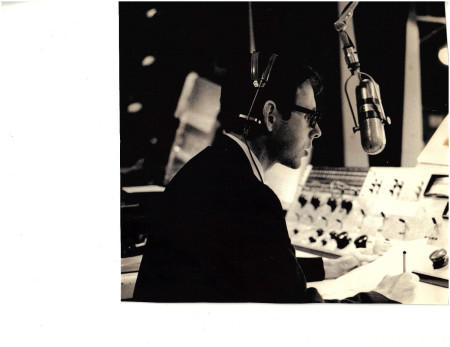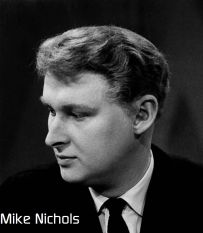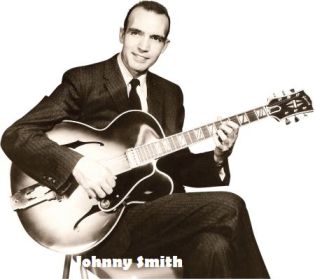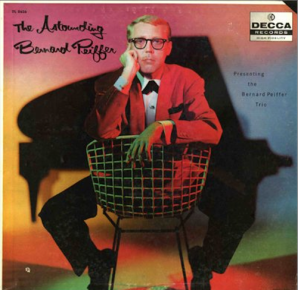During that time, after I’d transferred to Temple University in Phildelphia, I learned that WFLN was looking for announcers and decided to audition. Yes, the WFLN, which I had often heard as a student at Swarthmore. After all, I knew something about classical music, knew fairly well how to pronounce a few languages or to sound as if I did. Moreover, I had a pleasant, resonant microphone-ready, normally required speaking voice.
At the studios in an up-scale suburb, I was given a script to look at and rehearse. I may have been a little nervous. After all, this could have meant being salaried by a professional radio station while actually still in college. Bigger and more significant than several months of Saturdays following Cousin Larry for a few hours at WNAR while still at Swarthmore. This wasn’t Norristown. It was Philadelphia. It would also mean earning much more than at previous summer jobs in restaurants and delis.
The script contained all sorts of foreign words and phrases, many of which I knew. Moreover, my training as an actor helped me understand how to read the whole thing as if it were not just a collection of verbal hurdles.
Clearly I had left an impression, because that same day I was asked if I knew anything about jazz. Of course I did. I didn’t explain why; I’d listened to Morrison Crowley hosting the WFLN jazz show when I was at Swarthmore. I answered “yes.”
Not long thereafter I got the call. A shift, Monday through Friday from 10 a.m. to 2 p.m., plus the one-hour Saturday Concert of American Jazz. Where had Crowley gone? Why? No idea. But I didn’t ask.
I was told, however, that two previously regular staff announcers would get their jobs back if they wanted them after serving in the Korean War. One was Mitchell Krauss, later of CBS News.
For $50 a week (about $460 in 2017) my responsibilities included doing my own programming, that is, choosing the recordings I wanted to broadcast, standard at most stations then. Program Director Mike O’Donnell, of course, had to approve the choices, although selecting the jazz records was entirely up to me.
In the filing system everything was easy to find. All the recordings were filed by label and by the label’s catalog number. To find them we only had to look in The Schwann Catalog, a monthly listing of all the records known to be available in the U.S. It was invaluable for record stores. And for WFLN, too.

I also had to do what announcers did at most stations during broadcasts: keep a log of every element, noting when each record started and ended, plus when each commercial was read and its length; run the turntables; operate the console (called a “board”) that controlled the volume of the signals from the turntables, tape machines, and microphone while on the air; watch the VU (volume unit) meter on the console to make sure that there was no over-modulation causing distortion; read commercials live; gather news from an Associated Press news printer in another room; edit and read the news on the air; and, every hour, write down on a transmitter log the readings of the dials displaying the power of various components to make sure that they were within the correct ranges, plus, of course, talk to listeners on the phone if they had questions about something we broadcast.
And, at WFLN, there was an added duty for anyone on the air at 12 noon, that is, to have finished the music and the talking at precisely noon so as to connect via the board with WQXR in New York for a New York Times 15-minute newscast. Eventually, by the way, I’d be the one of those newscasters.
Actually, hardly any of these procedures were new for me; I’d learned about most of them in my radio course at Temple.
I hosted Morning Concert from 10 a.m. to noon and Afternoon Concert from 12:15 p.m. (after The New York Times news) until 3 p.m. Then, an older guy who looked to be in his 50s, Gil Morris (a.k.a. Morris Goldberg, as mentioned above), would take over Afternoon Concert, and Evening Concert until sign-off, when the transmitter tubes were turned off to cool overnight. Dig those clever program names.

The early morning show, 6 a.m. to 10 a.m., was hosted by Mike Nichols, who, as I mentioned above, was actually born Michael Igorevitch Peschkowsky. I learned that many years later. Yes, the famous Mike Nichols, just a few years prior to national fame. His show was titled Morning Potpourri. And his music selections seemed very interesting. Songs from the Broadway production of Kurt Weill and Langston Hughes’s Street Scene, theatre monologues by Ruth Draper, music by Alec Wilder conducted by Frank Sinatra. Plus lots of Baroque music.
Mike, only a couple of years older than I, always acted as if he didn’t like me. Why would he? I probably seemed like a know-it-all college kid. He also knew that, waiting to take over the console, I was staring at his ca. 1950 toupée. Me, feeling superior because I had real hair. Me, feeling superior because I thought I knew better than to play all that repetitive baroque music. And all that theatre stuff. That wasn’t classical.
In time, though, I’d learn to love Street Scene and Ruth Draper. By then, no commercial classical music radio station wanting to keep listeners would dream of broadcasting singing or talking that extensively in the early morning.
Mike was fired not long after I arrived, even though his program was very popular. It had been his duty to warm up and get the transmitter tubes humming one half-hour before he could broadcast. But he came in late once too often.
I became the host of Morning Potpourri. Most radio programs began and ended with theme music, the same music every day. Sort of a signature. I chose a dance from Prokofiev’s Romeo and Juliet. Lively contemporary music, the kind of music people should notice rather than that Baroque stuff. I was more interested in the kinds of music that I rarely heard in concerts than in the usual Haydn, Mozart, Beethoven, or Chopin. Nothing too modern, though. It took me years to get around to loving earlier music.
Meanwhile, I reveled in how many jazz LPs had already accumulated in the library. The mid-’50s, as it turned out, were great years for jazz recordings. By the early ’50s long-playing records, LPs, made it possible to re-issue and improve what previously had often sounded like scratchy 78s. An LP turned at 33 and 1/3revolutions per minute. 78s were at 78 rpms. 78s could at the most contain about five minutes per side. LPs could hold around 20. This meant that jazz musicians could stretch out their ideas to whatever length they wanted, as they had always done live when not compelled to think about doing their best under 78-rpm constraints. The mid-’50s saw the birth of jam session recordings, of audio visits to live concerts, as far back as Carnegie Hall concerts of the 1930s. And the brilliant informative liner notes were a godsend to someone like me, who, actually, had to learn about the artists to be able to share the information with listeners.
I began listening to jazz while the classical music was on the air, by listening on my headphones to a separate channel on the board. I had so much catching up to do. And it was such fun, listening to Bessie Smith’s urgent, sturdy blues, Jimmy Lunceford’s bouncy band, Benny Goodman at Carnegie Hall, Eddie Condon’s catchy groups, Buck Clayton’s jam sessions, Herbie Mann’s not-yet-folky flute, the incredible, fleeting fingers of pianist Mel Powell, jolly Erroll Garner, Charlie Parker’s pungencies, as well as performances by two much-admired artists I would later meet, interview, and hang out with, clarinetist Tony Scott and extraordinary cornetist Ruby Braff.
I pored over the information in Barry Ulanov’s History of Jazz in America so much so that the weekly, two-hour program, Concert of American Jazz, became as much a focus of my time and energy as all the rest of the hours combined, even though I didn’t like the title I’d inherited. There were many great recordings by artists from other countries, such as Django Reinhardt and a French pianist newly arrived in the U.S. to settle in Philadelphia, Bernard Peiffer, whom I interviewed. There were Swedish musicians, English musicians, Australian musicians, Cuban musicians.
Meanwhile, was my morning show programming as creative as Mike’s? Probably not. Did I do everything right? Probably. Was I ever late getting the station on the air? No.
One day Program Director Mike O’Donnell told me that a jazz guitarist, Johnny Smith, was in town to play at the Blue Note and asked if I’d like to interview him. Smith would come to the station. I quickly read about him to prepare for my first-ever interview. Perfect. He had the right background for talking on a classical music station. He had played Schoenberg and Gershwin with the New York Philharmonic.
WFLN had been getting letters and phone calls complaining about the jazz program even before I inherited it. The complainers hated the idea that their station, the only one in Philadelphia to present classical music, would not have classical music every minute of the broadcast day. I never found out if they had also resented Mike Nichols’ choices on his morning show; they probably did. Moreover, to some of them, jazz was like that noisy, intrusive pop music you could hear on other stations. FM to them meant Fine Music. And how could a growling trombone, bouncing boogie-woogie piano, a wailing trumpet, or Louis Armstrong’s gravelly voice possibly be considered fine?
But I was going to show them how wrong they were. An interview with Johnny Smith would do it. This gentle, well-spoken man, of course, explained how he loved classical music and went on to point out that the guitar was an instrument of choice as far back as the Renaissance.
Did that stop the complaints? Of course not. It never occurred to me that listeners who were against jazz wouldn’t be listening.

